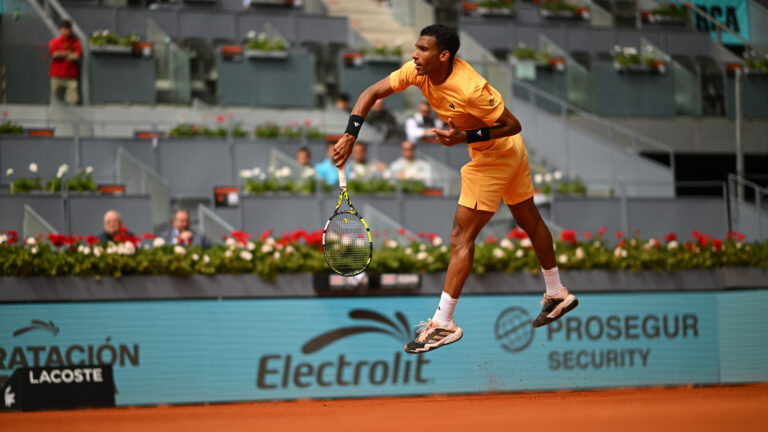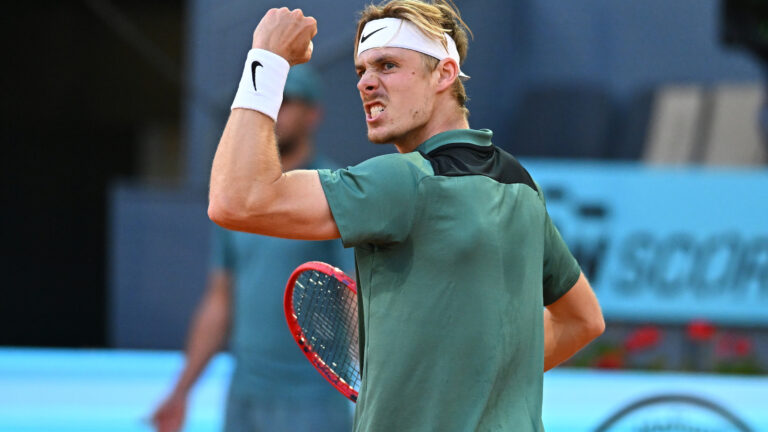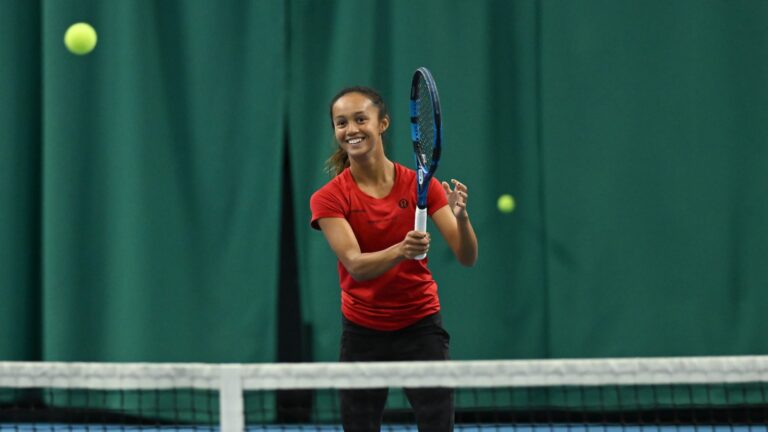TEBBUTT: DAVIS CUP PREP IN HALIFAX

The boys are back in town, and this time it’s in Halifax for the Davis Cup World Group Playoff against Colombia beginning on Friday.
Canada, with a team consisting of Milos Raonic, Vasek Pospisil, Frank Dancevic and Daniel Nestor, is playing to retain its place in the 16-nation World Group for 2015 following a first round loss last February in Tokyo sans Raonic and Pospisil – both were injured.

Probably more relevant than maintaining a World Group position is avoiding dropping down into Americans Group One competition next year with nations such as, potentially Brazil, Argentina, Ecuador, Dominican Republic, Uruguay, Venezuela and Mexico.
Over the years, Canada has made enough trips south to be well-acquainted with the often hostile environments, and red clay courts, in Latin American countries.
There are other benefits to staying in the World Group including having Hawk-Eye electronic line-calling for all ties, as well as business class air travel for all visiting nations (four players and a captain).
Because this weekend’s Playoff tie in Halifax is not actually in the World Group, there will be no Hawk-Eye. A few years ago that would not have been such as big deal. But on the heels of everyone watching the Rogers Cup and the US Open with Hawk-Eye readily available to provide definitive rulings on line calls, not having Hawk-Eye will likely make players a little more jumpy once the action starts at the Metro Centre in downtown Halifax.

Crowds are expected to anywhere from 4,500 to about 6,500 and tickets have been selling well. A top section at the hockey arena that was going to be curtained off has now been opened up for more spectators.

On Tuesday, a ‘sleeve-less’ Milos Raonic had a morning practice session against the two hitting partners on the Canadian team, Jesse Levine (a lefthander like Colombia’s Alejandro Falla) and first time squad member Brayden Schnur (on left above).
Levine is returning after elbow surgery last February and plans to use a protected ranking of about No. 200 to get back into action this fall at three Challenger events in the U.S., possibly preceded by a couple of Futures tournaments.

He’s got a sleeve on his left arm and the joke is that he had to ask Raonic’s permission to wear it. Raonic claimed he was the first to sport the sleeve – in Miami last March – while Levine believes he was wearing it before Raonic.
It’s that kind of frivolous banter that helps keep everyone enjoying the practice sessions in the lead-up to Friday’s opening singles.
The court at the Metro Centre was ready last Sunday, so some of the players were into their third day on Tuesday. It is the same Premier court surface that was used for ties in Vancouver against Spain and Italy in 2013.

In the early afternoon on Tuesday, Vasek Pospisil practiced with Levine under the watchful eye of Davis Cup captain Martin Laurendeau and coach Guillaume Marx.
He will be eager to do well this weekend after a troublesome back problem kept him out of the opening round tie in Japan in February. Raonic was also unavailable that weekend with a tendon tear just about his left ankle.
Singles players Raonic, ranked No. 7 and Pospisil, No. 43, are likely to be challenged by Santiago Giraldo, No. 33, and Falla, No. 73. Tennis Canada’s head man in Montreal, Louis Borfiga, is leery of the Colombians and said he expects “a tough battle” this weekend.

The South Americans (Falla left and Giraldo right above) have never made it to the World Group since it was instituted in Davis Cup in 1981 (Canada has made six appearances) and they seem highly motivated.
A source said the visitors been practicing hard and were at the Metro Centre until 8:30 p.m. on Monday evening.
Another factor giving the visitors hope is that they are one of a dwindling number of countries that have a solid doubles team that plays together on the tour – specialists Robert Farah and Juan-Sebastian Cabal.

The two teams are staying at separate hotels near the Halifax harbour. On Tuesday, the Canadian team’s hotel dressed up its front entrance as can be seen in the picture above.
HALIFAX POST CARD

This is a shot of friendly tugboat in the Halifax harbor, Canada’s largest port city on the east coast.
US OPEN 2014

Anita Aguilar/TENNIS.com
The 2014 US Open ended on Monday with Marin Cilic as the surprise winner of the men’s event following a 6-3, 6-3 , 6-3 victory over Kei Nishikori.
Neither player had been given much chance with top seed Novak Djokovic and No. 2 seed Roger Federer widely viewed as the consensus finalists. But Saturday’s semi-finals put an end to that when Djokovic, undoubtedly affected by the hot, humid weather which also diminished him in the French Open final against Rafael Nadal in June, lost to Nishikori and Federer was simply knocked off the court by the power-hitting and serving of an in-form Cilic playing what he later called “the best match of my life.”
There are a couple of interesting things about Cilic’s win. He, along with Juan Martin del Potro, Ernests Gulbis and Thiemo de Bakker were all born within a month of each other in August/September, 1988. All seemed to have much potential but Gulbis’s probably wasted his considerable talent by not being disciplined enough in his early years as a pro, and de Bakker turned out to be a bit of a flake.
So, at a time when they are all turning 26, del Potro, at the 2009 US Open, and Cilic, at the 2014 US Open, are the two to have made the breakthrough and won a Grand Slam.
Historically, the US Open has had the champions with the best pedigree. Since 1985, only Juan Martin del Potro in 2009 and Andy Murray in 2012 have been champions without at some point having ranked No. 1.
At Wimbledon, Pat Cash (1987), Michael Stich (1991), Richard Krajicek (1996) and Goran Ivanisevic (2001) were winners but never ranked No. 1.
At Roland Garros, Michael Chang (1989), Andres Gomez in (1990), Sergi Bruguera (1993-94), Albert Costa (2002), and Gaston Gaudio (2004) all triumphed but never made it to the top of the rankings.
At the Australian Open, Petr Korda (1998), Thomas Johansson (2002) and Stan Wawrinka (2014) were unlikely winners who have never reached No. 1.
While Cilic’s ranking has moved up to No. 9 with his win in New York, it appears unlikely he will ever rank No. 1, making what he did quite extraordinary, especially his 6-3, 6-4, 6-4 win over Federer in the semi-finals.

Anita Aguilar/TENNIS.com
As for the women’s event, there’s really not much to say. Women’s tennis over the past few years is all about Serena Williams. If she plays her best, it’s usually no contest as it was in the US Open women’s final on Sunday when she outclassed Caroline Wozniacki 6-3, 6-3.
The mystery is how Williams could not have gotten past the quarter-finals at any Grand Slam this year until the US Open. She had a back issue when she lost to Ana Ivanovic in the round-of-16 at the Australian Open but it’s still hard to understand how she lost 6-2, 6-2 to Garbine Muguruza in the second round of the French Open or 1-6, 6-3, 6-4 to Alizé Cornet in the third round at Wimbledon.
Many were surprised when Williams played Stanford, Montreal (Coupe Rogers) and Cincinnati back-to-back-to-back leading into the US Open. She won in Stanford and Cincinnati and lost to sister Venus in the Montreal semi-finals. That obviously got her in a great groove and she was untouchable at the US Open.
She turns 33 on September 26 and appears not to be slowing down. She has now joined Martina Navratilova and Chris Evert with 18 Grand Slam titles. It seems entirely possible she will reach 20 Grand Slams or more, unless players like Petra Kvitova, Wozniacki, Eugenie Bouchard and other young up-and-comers are able to emerge as credible challengers in 2015.


